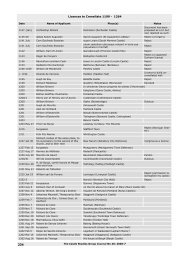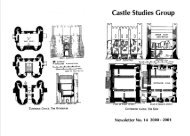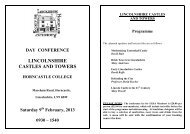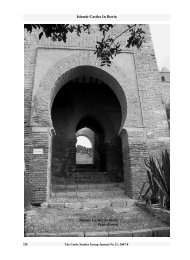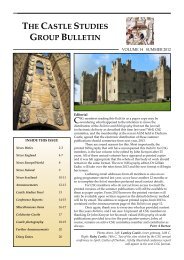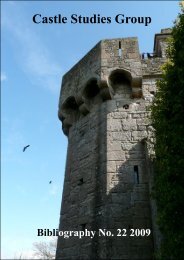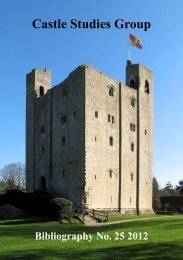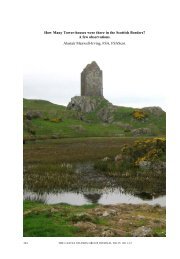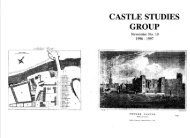Machicolation: some postscripts. - Castle Studies Group
Machicolation: some postscripts. - Castle Studies Group
Machicolation: some postscripts. - Castle Studies Group
Create successful ePaper yourself
Turn your PDF publications into a flip-book with our unique Google optimized e-Paper software.
<strong>Machicolation</strong>: <strong>some</strong> <strong>postscripts</strong>.England. 6 The Lincoln “keep” was <strong>some</strong>34m by 19m; the White Tower is 36m by31m. They publish floor plans of a hypotheticalreconstruction based on Gem’swork 7 . Lincoln differs of course in havinga relatively undefended narthex-likeground-floor space (or undercroft) withthree doorways to the west, doorwayswhich may have given access to the cathedralor <strong>some</strong> pre-existing church 8 but alsoserved to add modelling to the building asarcading does at Norwich and the WhiteTower, but more dramatically and splendidly.The original arrangements to theeast, abutting the church are unknown. It istempting to wonder whether the vulnerabilityof these doorways prompted the thinkingthat led to including the machicolation.The slots could have been used to pourwater on to fires lit against timber doorsthat were larger and more accessible thanthose of a typical keep, as well as to shootor drop missiles on to besiegers.The only mention of anything likemachicolation in classical writing(Vegetius in the late 4th century) recommendsslots as a way of dousing such firesrather than as a way of attacking besiegers.It is speculation, but as a cleric Remegiuswould have had access to classical worksand just possibly could have read Vegetius,especially as he was a bishop with militaryresponsibilities. Although the actual formof these slots is different from the typeapparently envisaged by Vegetius,Remegius’s adoption of his suggestionmight be an introduction of machicolationunconnected with its evolution in the eastand in Spain.As Stocker and Vince say“…Remegius was behaving not as a bishop,but primarily as a conventional greatNorman Lord….symbolising his Lordshipin the conventional Norman way by constructinga massive, dominant ....donjon……” In doing so, he appears to havecreated a building form with special needsand to have introduced or invented thedevice of machicolation to answer theseneeds.At the other end of the mediaevaltimescale, there are late-ish examples ofmachicolation that are worth examining forthe light they can throw on the use of thedevice in the final years before its phasingout.Each example is worth knowing aboutin itself.Soncino castle, the Rocca Sforzesca,near Milan was built in about 1473(Figs. 4, 5). It has rectangular towers and acontinuous run of machicolation along thewalls all in a style similar to many northItalian castles of the period, but it also hasa single round angle tower with two layersof machicolation, one higher than the generalrun of wall-top machicolation and onelower. This tower is higher than the wallsand in proportion unlike the torrioni of arocca such as that at Imola which is of avery similar date. There the towers havebeen reduced to the height of the walls inresponse to attack by cannon. We mustassume that the Soncino tower was builtwith an awareness of the potential of gunpowderartillery, in both defence and attack,although it may represent anon-the-hoof change to the design 9 . Whilethere seems to be a wish here to demonstrateestablished authority by a continueduse of machicolation and other mediaevalarchitectural forms in the castle overall, inthe use of a circular tower, more resistantto cannon fire than the rectangular formthat had been common in North Italy, andin the use of batter at the base of the towersand walls, there is a recognition of the needfor change. The round tower is to all intentsand purposes a torrione, despite its proportionsand its height, although one that placesimportance on machicolation.This strange arrangement of doubled-upmachicolation might be used tosupport almost any theory about the purposeof machicolation: an enthusiasm forThe <strong>Castle</strong> <strong>Studies</strong> <strong>Group</strong> Journal No 24: 2010-11 216



